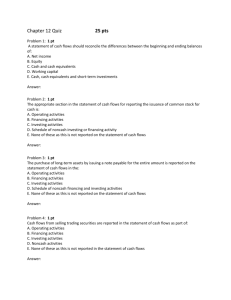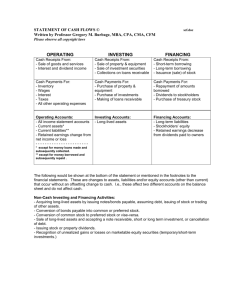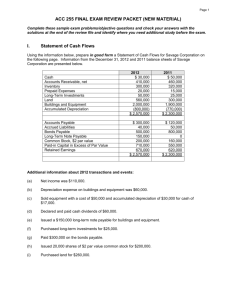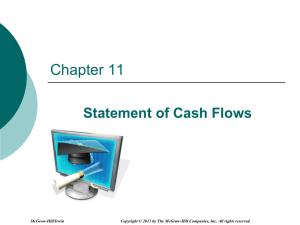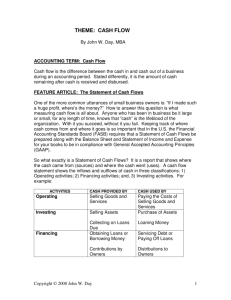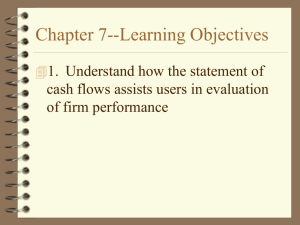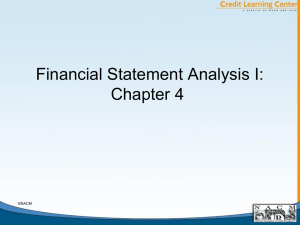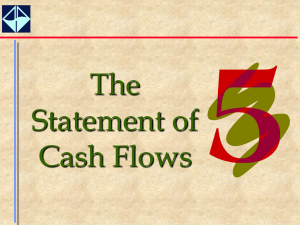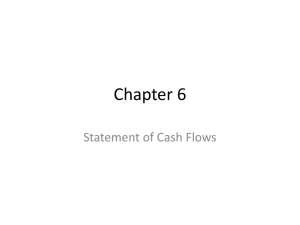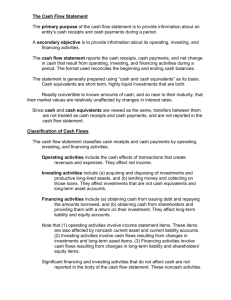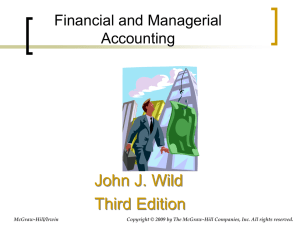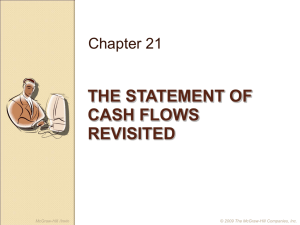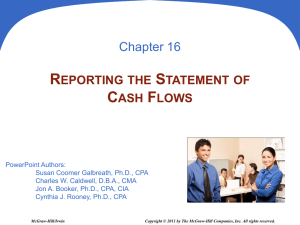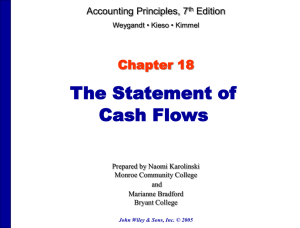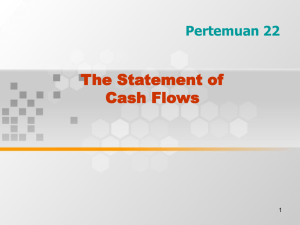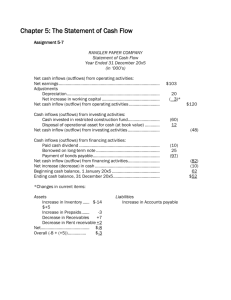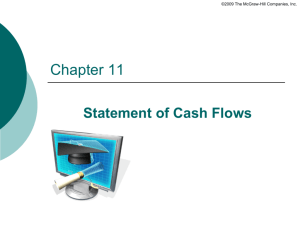answers to questions
advertisement
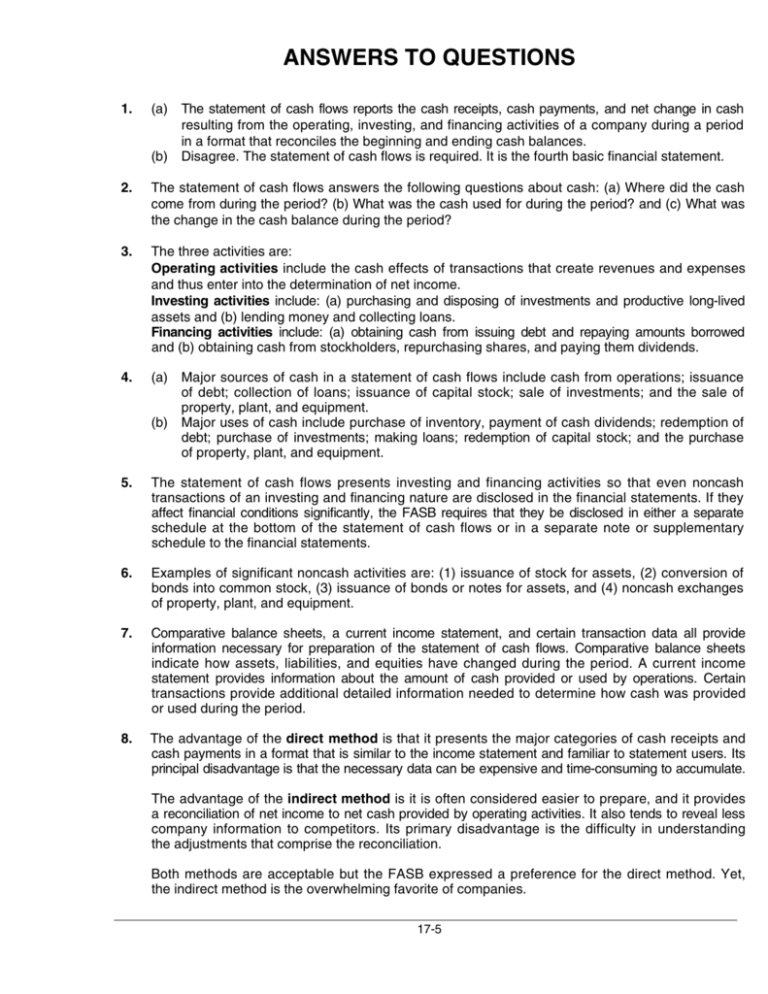
ANSWERS TO QUESTIONS 1. (a) The statement of cash flows reports the cash receipts, cash payments, and net change in cash resulting from the operating, investing, and financing activities of a company during a period in a format that reconciles the beginning and ending cash balances. (b) Disagree. The statement of cash flows is required. It is the fourth basic financial statement. 2. The statement of cash flows answers the following questions about cash: (a) Where did the cash come from during the period? (b) What was the cash used for during the period? and (c) What was the change in the cash balance during the period? 3. The three activities are: Operating activities include the cash effects of transactions that create revenues and expenses and thus enter into the determination of net income. Investing activities include: (a) purchasing and disposing of investments and productive long-lived assets and (b) lending money and collecting loans. Financing activities include: (a) obtaining cash from issuing debt and repaying amounts borrowed and (b) obtaining cash from stockholders, repurchasing shares, and paying them dividends. 4. (a) Major sources of cash in a statement of cash flows include cash from operations; issuance of debt; collection of loans; issuance of capital stock; sale of investments; and the sale of property, plant, and equipment. (b) Major uses of cash include purchase of inventory, payment of cash dividends; redemption of debt; purchase of investments; making loans; redemption of capital stock; and the purchase of property, plant, and equipment. 5. The statement of cash flows presents investing and financing activities so that even noncash transactions of an investing and financing nature are disclosed in the financial statements. If they affect financial conditions significantly, the FASB requires that they be disclosed in either a separate schedule at the bottom of the statement of cash flows or in a separate note or supplementary schedule to the financial statements. 6. Examples of significant noncash activities are: (1) issuance of stock for assets, (2) conversion of bonds into common stock, (3) issuance of bonds or notes for assets, and (4) noncash exchanges of property, plant, and equipment. 7. Comparative balance sheets, a current income statement, and certain transaction data all provide information necessary for preparation of the statement of cash flows. Comparative balance sheets indicate how assets, liabilities, and equities have changed during the period. A current income statement provides information about the amount of cash provided or used by operations. Certain transactions provide additional detailed information needed to determine how cash was provided or used during the period. 8. The advantage of the direct method is that it presents the major categories of cash receipts and cash payments in a format that is similar to the income statement and familiar to statement users. Its principal disadvantage is that the necessary data can be expensive and time-consuming to accumulate. The advantage of the indirect method is it is often considered easier to prepare, and it provides a reconciliation of net income to net cash provided by operating activities. It also tends to reveal less company information to competitors. Its primary disadvantage is the difficulty in understanding the adjustments that comprise the reconciliation. Both methods are acceptable but the FASB expressed a preference for the direct method. Yet, the indirect method is the overwhelming favorite of companies. 17-5 Questions Chapter 17 (Continued) 9. When total cash inflows exceed total cash outflows, the excess is identified as a “net increase in cash” near the bottom of the statement of cash flows. 10. The indirect method involves converting accrual net income to net cash provided by operating activities. This is done by starting with accrual net income and adding or subtracting noncash items included in net income. Examples of adjustments include depreciation and other noncash expenses, gains and losses on the sale of noncurrent assets, and changes in the balances of current asset and current liability accounts from one period to the next. 11. It is necessary to convert accrual-based net income to cash-basis income because the unadjusted net income includes items that do not provide or use cash. An example would be an increase in accounts receivable. If accounts receivable increased during the period, revenues reported on the accrual basis would be higher than the actual cash revenues received. Thus, accrual-basis net income must be adjusted to reflect the net cash provided by operating activities. 12. A number of factors could have caused an increase in cash despite the net loss. These are (1) high cash revenues relative to low cash expenses; (2) sales of property, plant, and equipment; (3) sales of investments; (4) issuance of debt or capital stock, and (5) differences between cash and accrual accounting, e.g. depreciation. 13. Depreciation expense. Gain or loss on sale of a noncurrent asset. Increase/decrease in accounts receivable. Increase/decrease in inventory. Increase/decrease in accounts payable. 14. Under the indirect method, depreciation is added back to net income to reconcile net income to net cash provided by operating activities because depreciation is an expense but not a cash payment. 15. The statement of cash flows is useful because it provides information to the investors, creditors, and other users about: (1) the company’s ability to generate future cash flows, (2) the company’s ability to pay dividends and meet obligations, (3) the reasons for the difference between net income and net cash provided by operating activities, and (4) the cash investing and financing transactions during the period. 16. This transaction is reported in the note or schedule entitled “Noncash investing and financing activities” as follows: “Retirement of bonds payable through issuance of common stock, $1,700,000.” *17. A worksheet is desirable because it allows the accumulation and classification of data that will appear on the statement of cash flows. It is an optional but efficient device that aids in the preparation of the statement of cash flows. *18. Net cash provided by operating activities under the direct approach is the difference between cash revenues and cash expenses. The direct approach adjusts the revenues and expenses directly to reflect the cash basis. This results in cash net income, which is equal to “net cash provided by operating activities.” 17-6 Questions Chapter 17 (Continued) *19. (a) Cash receipts from customers = Revenues from sales (b) Purchases = Cost of goods sold + Decrease in accounts receivable – Increase in accounts receivable + Increase in inventory – Decrease in inventory Cash payments to suppliers = Purchases + Decrease in accounts payable – Increase in accounts payable *20. Sales ........................................................................................................................................... Add: Decrease in accounts receivables.............................................................................. Cash receipts from customers ............................................................................................... $2,000,000 200,000 $2,200,000 *21. Depreciation expense is not listed in the direct method operating activities section because it is not a cash flow item—it does not affect cash. 17-7
